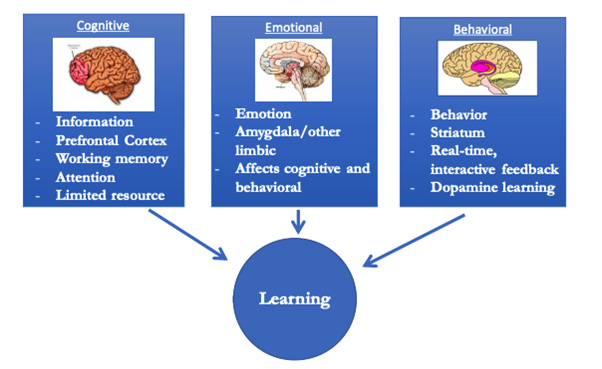Did you know that 85% of job success depends on having well-developed people skills, while only 15% depends on technical skills? Recognizing their value, companies invest large sums of money (over $200 billion worldwide) in soft skills training solutions, yet they are not as effective as learning programs deployed for hard skills. Why? The answer can be found by examining the neuroscience of learning. Let’s explore the brain with Todd Maddox, learning scientist and research fellow at Amalgam Insights.
Todd Maddox and the neuroscience of learning
Todd Maddox has conducted extensive studies in psychology and neuroscience to help us understand how the brain learns. By taking into consideration the inner workings of the brain, L&D departments can develop a more effective solution for their soft skills training needs.
The neuroscience of learning: the ‘What’, the ‘How’ and the ‘Feel’
According to Maddox, the brain relies on three different learning systems: cognitive, behavioral and emotional. Each system operates in a different part of the brain, as seen in the diagram below:

In addition, each system is wired to learn a different set of skills- the ‘What’, the ‘How’ and the ‘Feel’.
The cognitive system–the ‘What’
- learns fact-based knowledge and information
- is limited to a person’s working memory and attention span
- is subject to the forgetting curve
- needs repetition to transform short-term memory into long-term memory
The behavioral system–the ‘How’
- takes what people know and applies it to situations
- learns through interaction and real-time corrective feedback
- is more likely to repeat rewarded behaviors and suppress punished behaviors
- requires physical repetition and gradual incremental changes in behavior to develop ‘muscle memory’
The emotional system–the ‘Feel’
- is capable of reading a situation and engaging with the appropriate set of behaviors
- develops situational awareness, a nuanced understanding of situations and people
- processes situations and adapts behaviors in split seconds
- requires role-plays with context-rich, real-life scenarios to develop increased emotional learning
Learning knowledge vs. people skills
Technical know-how is always changing, and L&D departments have to adapt their training programs to fulfil a company’s relevant needs at any given time. We can never really know what the future holds for hard skills. Soft skills, on the other hand, are always needed, regardless of innovations in processes or technology. For example, active listening and leadership are critical people skills that are always needed, in addition to effective communication. Team members who can communicate effectively will be able to avoid unconscious biases and take on appropriate behaviors in the workplace. Other essential soft skills are respect, compassion and empathy. A team can demonstrate well-polished hard skills, but without the ability to cooperate and work together, those hard skills will be lost amidst a climate of misunderstanding and frustration.
With that in mind, where exactly in the brain does soft skills acquisition take place? For starters, in the behavioral system. This is where we gain an understanding of our and others’ behaviors and develop our interpersonal skills. However, this is just part of the picture. A leader may know the characteristics of effective communication and may even have a strong behavioral repertoire, but if he or she does not have enough emotional intelligence, then genuine communication can never really occur. The qualities that really lie at the heart of people skills are awareness and sensitivity. Putting ourselves in the shoes of another builds people skills, and this phenomenon happens in the amygdala and other limbic structures of the brain.
Although we still don’t know in detail how the emotional system works, one thing is clear: The emotional system strongly influences the cognitive and behavioral systems. Given that hard skills learning is closely linked to soft skills learning, why then is soft skills training often so ineffective?
The pitfalls of microlearning for soft skills development
Microlearning, characterized by short bursts of learning, has revolutionized the L&D sector. When combined with testing and targeted retraining that is spaced over time, it is capable of transforming short-term memory into long-term memory. This is great for engaging the cognitive learning system and acquiring technical skills. However, it’s not so great for the development of people skills and situational awareness, and can even be detrimental.
The difficulty is that behavioral skills learning requires a more nuanced approach, one that focuses on training multiple behaviors in various settings. To induce long-term behavioral change, people need to be trained to think on their feet. This can only happen in situations where there is randomness and the uncertainty of what is coming next. A person becomes aware of a situation and decides how to behave in a matter of seconds. Microlearning does not allow learners to react quickly in a multi-faceted setting as it focuses on one topic, trains it, then focuses on another, and so on.
Because people skills and situational awareness are developed by the behavioral and emotional learning systems in the brain, their processing characteristics do not align with microlearning techniques.
Building impactful training with the right solutions
Soft skills are the building blocks of corporate success. They will always be needed no matter how the times change and can influence how effectively hard skills are put into practice. However, we cannot apply the same approach to people skills learning as we do to knowledge learning. The way we interact and communicate with others and perceive situations is very nuanced. Therefore, we need a specific learning solution where we can:
- evaluate the strengths and challenges of each employee’s people skills
- get a personalized learning paths
- build scenario-based training course combining a variety of learning activities
CK Connect by CrossKnowledge offers personalized people skills training for each employee–because a one-size-fits-all approach will not deliver the soft skills training your organization needs. Discover how CK Connect can help you upskill and reskill your workforce with impact!